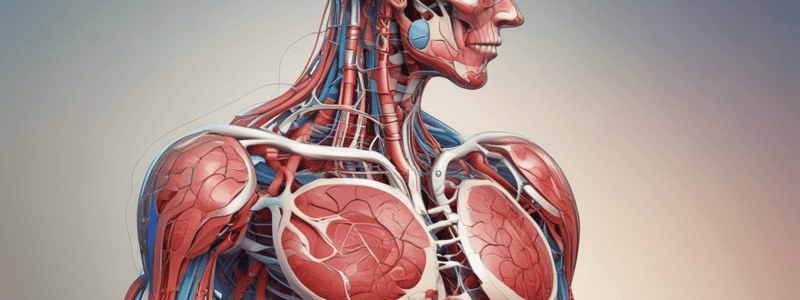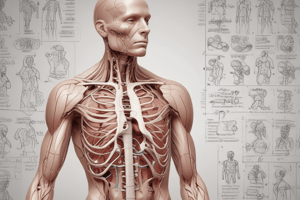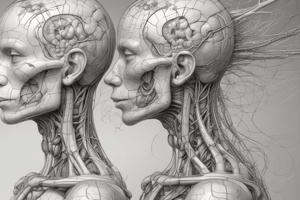Podcast
Questions and Answers
What is the term used for removal of palatine tonsils?
What is the term used for removal of palatine tonsils?
- Tonsillectomy (correct)
- Lymphadenectomy
- Splenectomy
- Thymectomy
Which cells engulf the pathogen to achieve antigen presentation?
Which cells engulf the pathogen to achieve antigen presentation?
- Macrophages (correct)
- Neutrophils
- Dendritic cells
- Lymphocytes
What is the term used to describe a severe hypersensitivity reaction?
What is the term used to describe a severe hypersensitivity reaction?
- Anaphylaxis (correct)
- Inflammation
- Autoimmune disease
- Allergy
Which structure is related to the processing and maturation of T lymphocytes?
Which structure is related to the processing and maturation of T lymphocytes?
What is the term used to describe the removal of worn out blood cells from circulation?
What is the term used to describe the removal of worn out blood cells from circulation?
What is the term used to describe a group of proteins secreted by virally infected cells?
What is the term used to describe a group of proteins secreted by virally infected cells?
What type of cells remember if an antigen is presented later in the future?
What type of cells remember if an antigen is presented later in the future?
What is the term used to describe the absorption of tissue fluid and transportation towards the heart?
What is the term used to describe the absorption of tissue fluid and transportation towards the heart?
Which cells destroy pathogens by punching holes in their cell membranes?
Which cells destroy pathogens by punching holes in their cell membranes?
What is the term used to describe the process of using dead pathogens to stimulate antibody production?
What is the term used to describe the process of using dead pathogens to stimulate antibody production?
What type of hormone is secreted by the thyroid gland?
What type of hormone is secreted by the thyroid gland?
What is the name of the gland that secretes melatonin?
What is the name of the gland that secretes melatonin?
What is the name of the hormone that helps regulate salt and water balance?
What is the name of the hormone that helps regulate salt and water balance?
What is the term for the sense of smell?
What is the term for the sense of smell?
What is the name of the structure that prevents gastric reflux?
What is the name of the structure that prevents gastric reflux?
What is the term for the cloudy lens of the eye?
What is the term for the cloudy lens of the eye?
What is the name of the tube that connects the pharynx and middle ear?
What is the name of the tube that connects the pharynx and middle ear?
What is the name of the structure that separates the outer ear from the middle ear?
What is the name of the structure that separates the outer ear from the middle ear?
What is the term for the sensation of pain?
What is the term for the sensation of pain?
What is the name of the structure that produces tears?
What is the name of the structure that produces tears?
Flashcards are hidden until you start studying
Study Notes
Infections and Immunity
- An infection is often accompanied by leukocytosis
- Leukocytosis is a condition where the white blood cell count increases
- Spleen removes worn out blood cells from circulation
- Lymphatic vessels and nodes are responsible for removing excess fluids and proteins from the body
Lymphatic System
- Lymph nodes are populated with lymphocytes and macrophages
- Lymphatic capillaries absorb tissue fluid and transport it toward the heart
- Lacteals are located within the intestinal villus and are responsible for fat absorption
- Thymus gland is responsible for the processing and maturation of T lymphocytes
Immunity
- Band T cells are lymphocytes
- Tonsillectomy is the removal of palatine tonsils
- Anaphylaxis is a severe hypersensitivity reaction
- Naturally acquired active immunity is when you have measles as a child
- Antigen is also called an allergen
- Band T cells represent specific immunity
- Redness, heat, swelling, and pain are indicative of infection/inflammation
Cells and Immunity
- Macrophages engulf the pathogen to achieve antigen presentation
- Killer T cells destroy pathogens by punching holes in their cell membranes
- Memory T cells remember if an antigen is presented later in the future
- Infections are most common in people with AIDS
- Immunization is the term used for dead pathogens to stimulate antibody production
Miscellaneous
- Antipyretic is a drug that lowers a fever
- Interferons are a group of proteins secreted by virally infected cells
- Nonspecific immunity is the first line of defense against infection, whereas specific immunity is targeted against specific pathogens
Endocrine System
- T3, T4, and calcitonin are secreted by the thyroid gland
- Estrogen, progesterone, and testosterone are secreted by the gonad
- Calcium and parathyroid hormone control plasma levels of calcium
- Hyperglycaemia is caused by a deficiency of insulin
- Melatonin is secreted by the pineal gland
- Insulin and glucagon are secreted by the pancreas and regulate blood glucose
- Acute adrenal insufficiency is caused by the sudden withdrawal of cortisol
- Aldosterone is a mineralocorticoid that helps regulate salt and water balance
Digestive System
- Mechanical digestion refers to the chewing of food
- Liver is the organ that detoxifies drugs, stores vitamins, and synthesizes clotting factors
- Enamel, dentin, and cementum are related to teeth
- Emulsification is most associated with bile
- Gingiva refers to the gums
- Liver produces bile
- Obstruction of the common bile duct causes jaundice
- Paralytic ileus is the slowing or stoppage of GI motility
- Absorption is most related to microvilli
- Cellulose is a dietary fiber that cannot be digested by humans
- The fundus, body, and pylorus are part of the stomach
- The duodenum and jejunum are the site of absorption for most end products of digestion
- The lower oesophageal sphincter prevents gastric reflux
Sensory Organs
- Nociceptors detect pain
- Olfaction refers to the sense of smell
- The gustatory sensation is most related to taste buds
- The iris is the colored part of the eye
- The lacrimal gland secretes tears
- An increase in IOP causes damage to the retina and blindness
- A cloudy lens is called a cataract
- The semicircular canals and cochlea are located in the inner ear
- The malleus, incus, and stapes are called ossicles
- The Eustachian tube connects the pharynx and middle ear
- The tympanic membrane separates the outer ear from the middle ear
- Semicircular canals are concerned with balance
- Rods and cones are visual receptors
Studying That Suits You
Use AI to generate personalized quizzes and flashcards to suit your learning preferences.




